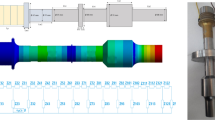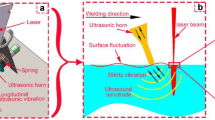Abstract
An ultrasonic transducer, consisting of two piezoelectric ceramic disks and two resonance rods, is optimized with respect to the shape of the two resonance rods in order to maximize the amplitude of the vibrating tip. The mathematical model is presented and a finite element model of the transducer is set up. Harmonic analysis (forced vibration) is used for calculation of resonance frequency, vibration mode, amplitude and phase. The resulting optimal shape is presented. The numerical analysis shows that the new design improves the amplitude 4.0 times. The improved transducer has been tested against the standard transducer and experiments show good agreement with theoretical results. A special design of the ultrasonic transducer for sonar applications has also been investigated. Applications of the improved ultrasonic transducer are more efficient transducers in high energy applications such as ultrasonic welding, drilling, disruption, cleaning, and sonar and underwater communication.
Similar content being viewed by others
References
Allik, H.; Hughes, T.J.R. 1970: Finite element method for piezoelectric vibration.Int. J. Num. Meth. Eng. 2, 151–157
Arora, J.S. 1989:Introduction to optimum design. New York: McGraw Hill
Cook, R.D.; Malkus, D.S.; Plesha, M.E. 1989:Concepts and applications of finite element analysis. New York: Wiley
Haftka, R.T.; Gürdal, Z.; Kamat, M.P. 1990:Elements of structural optimization. Dordrecht: Kluwer
Kagawa, Y.; Yamabuchi, T. 1976: Finite element approach for a piezoelectric circular rod.IEEE Trans. Sonics & Ultrasonics 6, 379–385
Kinsler, L.E.; et al. 1982:Fundamentals of acoustics. New York: Wiley
Lerch, R. 1988: Finite element analysis of piezoelectric transducers.Ultrasonics Symp., pp. 643–654
Naillon, M.; Coursant, R.; Besnier, F. 1983: Analysis of piezoelectric structures by a finite element method.Acta Electronica
Ostergaard, D.F., Pawlak, T.P. 1986: Three-dimensional finite elements for analyzing piezoelectric structures.Ultrasonics Symp., pp. 639–644
Whitney, J.M. 1987:Structural analysis of laminated anisotropic plates. Technomic Publishing Company Inc.
Zienkiewicz, O.C.; Cheung, Y.K. 1967:The finite element method in structural and continuum mechanics. New York: McGraw Hill
Zienkiewicz, O.C.; Taylor, R.L. 1989/1990/1991:The finite element method. London: McGraw Hill
Author information
Authors and Affiliations
Additional information
Communicated by P. Pedersen
Rights and permissions
About this article
Cite this article
Hansen, H.H. Optimal design of an ultrasonic transducer. Structural Optimization 14, 150–157 (1997). https://doi.org/10.1007/BF01812517
Received:
Issue Date:
DOI: https://doi.org/10.1007/BF01812517




